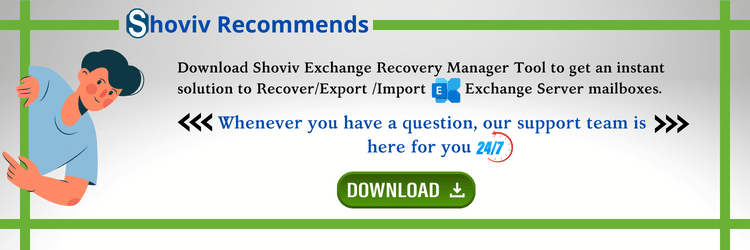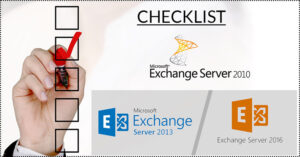Are you facing the issue of EDB Corruption and want to recover as soon as possible without spending much time in the execution of Exchange Database Recovery?
EDB Files are crucial for Exchange Server, and they should be in a good state of health for stress-free execution. So, firstly, here we’ll discuss what the EDB file is?
Download a trial version of Exchange EDB Recovery Tool to know in a better way.
EDB- A Brief Discussion
EDB as known as Exchange Database created by Exchange Server to store Exchange mailbox data. Exchange database stores both; in process as well as stored non-SMTP messages in the b structure with a top-level and child nodes.
Location of Exchange Database in different versions:
| Exchange Versions | Storage location |
| Exchange 2000 & 2003 | C:\Program Files\Exchsrvr\MDBDATA\Priv1.edb |
| C:\Program Files\Exchsrvr\MDBDATA\Pub1.edb | |
| Exchange 2007 | C:\Program Files\Microsoft\Exchange Server\Mailbox\First Storage Group\Exchange Database.edb |
| C:\Program\Files\Microsoft\Exchange Server\Mailbox\First Storage Group\Public Folder Database name.edb | |
| Exchange 2010 | C:\Program Files\Microsoft\Exchange Server\V14\Mailbox Database\Database.edb |
| C:\Program Files\Microsoft\Exchange Server\V14\Public Folder Database\Public Folder Database.edb | |
| Exchange 2013 | C:\Program Files\Microsoft\Exchange Server\V15\Mailbox\Exchange database name |
| Exchange 2016 & 2019 | C:\Program Files\Microsoft\Exchange Server\V15\Mailbox\Exchange Database Name.edb |
| Run the command to Find Exchange Database in any version
Get-MailboxDatabase –Status | select “edbfilepath” |
|
Reasons for EDB Corruption:
Here, we are mentioning some of the reasons behind the Exchange Database (EDB) files corruption:
- Exchange Server failure
- Corrupt header info
- Exchange error messages
- Emergent system termination
- Virus intrusions
- The error of the Jet engine
- The error of the Hard disk
EDB corruption is a serious issue as the whole mail database loses forever, if not settled in downtime. None can take risks either individual or professional. It requires immediate action.
There are some inbuilt tools available to recover databases from corrupt or inaccessible EDB files. You can endeavor to rescue your database with those tools. If you have an updated and valid backup of your Exchange database, you can try and get your mailbox database. But if you don’t have the backup, then you require to utilize in-built tools Eseutil and Isinteg.
A way for Exchange Database Recovery from Corrupt EDB Files
There are two free inbuilt tools of Microsoft Exchange Server rescue corrupt Exchange database Files – Eseutil and Isinteg.
Well, before starting the execution of EDB files rescue, you should do a few things:
- Make a duplicate copy of the database
- Dismount EDB files from Exchange Server
- And be ensure you have enough free disk space to execute a recovery process
- The default location of the tool is C:\Program Files\Exchsrvr\bin
These tools check the database’s consistency, integrity, and endeavor to rescue corrupt, damaged, or ingress-able EDB files merely with minor corruptions.
Eseutil.exe to recover Exchange Database?
ESEUTIL is a utility to defragment Exchange Server to check the integrity of the Exchange database and repair a damaged or lost database.
The ESEUTIL.exe can be found in the EXCHSRVRBIN directory. Because this directory is not in the system path, you must either open the tool in the BIN directory or add the EXCHSRVRBIN directory to the system path.
- Press Window + R and type cmd in the text box.
- Now navigate to the Eseutil utility location, i.e.,
C:/program files/Exchange Server/bin.
- Then enter Eseutil in the command line.
- Now enter the following command line to recover severely corrupted Exchange database.
Eseutil/p C:\Program Files\Exchsvr\mdbdata\Exchangedatbase.edb
- After the Exchange database recovery, run the Eseutil/d and defragment the Exchange database.
Eseutil/d C:\Program Files\Exchsvr\mdbdata\Exchangedatbase.edb
Now, run the Isinteg.exe to check the integrity
Syntax to run the Isinteg.exe
isinteg -pri|-pub [-fix] [-detailed] [-verbose] [-l logfilename] -test testname[[, testname]…]
Here the Eseutil and isinteg utility process to recover Exchange database gets over. Now as you can see it’s quite complicated and is like a walk on eggshells; a single misstep and you will lose all your Exchange database data.
For a risk-free and hastily Exchange database recovery, one can use the Shoviv Exchange Database recovery software.
Recover Exchange Database like professionals:
The Shoviv Exchange EDB Recovery tool has the fullest feature that merely does not assist you in the recovery of the Exchange database but also in the migration, exportation, and much more. The Exchange Server Recovery tool facilitates you risk-free recovery of Exchange mailboxes with its attribute after any event of Exchange disruption by its feature. Migration of Office 365 mailboxes (including archived mailboxes and public folders) without Outlook.
Features of the Shoviv Exchange Database Recovery Software
The tool is coded for professionals, and their needs are prioritized throughout the development process. The following are a few of its advanced features that help users to recover the Exchange database desirably.
Convert EDB to PST:
Exchange Database Recovery tool is the fullest feature, yeah this is right because you can do much more except the recovery and rescue execution by the fabulous tool. You can export offline EDB mailboxes to the PST outlay until you don’t install MS Outlook on your system. With this tool, you have the option to restore the EDB file to a new/existing PST file without changing the previous hierarchy of the mailbox.
Migration from Office 365 to Office 365:
With this tool, you can do the execution of Office 365 account mailboxes migration to another Office 365 mailboxes. It also gives you a feature to utilize it when you wanted to export your Office 365 mailbox to PST, online Exchange Server mailboxes without affecting the users.
Live Exchange to Live Exchange Migration Execution:
Users can migrate older databases to the new version of Exchange without any risk of data loss. It is the easiest way to migrate from one Exchange Server to another Exchange Server.
Some Exclusive features to enhance the Exchange Database recovery process
Deletion Recovery:
The user can execute Exchange Database Recovery from the deprave Exchange email databases and from Exchange backups. It restores deleted mailboxes, messages, folders, file attributes, contacts, calendars, notes, and much more in the terrific cases of Exchange Server Crash or Emergent issues.
Report Analyzer & Operation Log history details:
Users can analyze the mailbox data flow of both EDB files and Live Exchange based on a prior parameter such as sender, receiver, attribute timing, and messages. It is the easiest way to track the status and details of all operations performed in a particular duration. You can take a good glance at operation logs with the details by the Exchange Database Recovery Tool.
Incremental Export:
Process interruption is the worst scenario for any task as you need to start the process again. Fortunately, Shoviv Exchange Database Recovery tool offers an incremental export option to resume the interrupted processes. Also, if your Exchange Databse has duplicate items then don’t worry, the tool will filter out duplicate items and effectively prevent duplicity.
Specific Search Options:
One of the best features of this Exchange Database Recovery Tool is the specific search option. With the help of search options or advanced search features, it is easy to find specific emails or items within multiple mailboxes. Easily you can find any message consisting of sentence/words, search within the attribute, Data range, and much more. You can save custom searches too, for saving your precious time.
Database Previewer:
You can preview and read the information of the selected items or messages from source and destination lists by only double-clicking on the chosen file in the preview section.
Wrapping Up:
We hope you have made up your mind to download the free version of the Exchange Database Recovery Tool to get satisfaction. A free trial version of the software is also available to download; you can check the software working using the free demo version.
FAQs
New-MailboxRepairRequest -Mailbox <MailboxIdParameter> [-Archive <SwitchParameter>] <COMMON PARAMETERS>
- How to Backup and Restore Emails in Webmail? - March 25, 2025
- How to Migrate Outlook to New Computer? - February 15, 2025
- Fix If Outlook Cannot Display the Specific Folder Location - February 1, 2025





